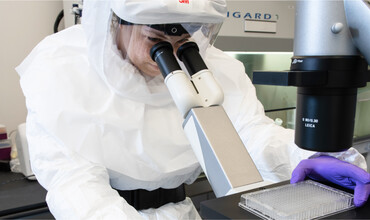Draper is at the forefront of Human Spaceflight and Exploration, delivering advanced guidance, navigation, and control (GN&C), fault-tolerant computing and software design for critical missions. With a legacy rooted in the Apollo program, Draper continues to pioneer innovative technologies that ensure the safety and success of astronauts on missions to the Moon, Mars, and beyond.
Technology Areas

Spacecraft Guidance, Navigation and Control (GN&C)
Draper leverages GN&C systems it developed for the Apollo and Space Shuttle missions as well as automation for the International Space Station. Draper is a key contributor to programs including Orion, Space Launch System, Cygnus, Dream Chaser, CYGNSS, Stratolaunch, Restore-L, ispace, HLS, and many others.
Additional Information
Lunar Landing
-
Inertial Measurement
-
Guidance, Navigation, and Control
-
Physical Sensing and Timing
-
High Assurance Systems
-
Design for Harsh Environments
-
Communications and RF Systems
-
Cyber-Physical Systems Security
-
Human-System Engineering
-
Data Analytics and Machine Learning
-
Autonomy and Perception Software
-
Electromechanical Systems
Draper’s heritage in lunar landing GN&C and highly reliable computing dates back to our role in NASA’s Apollo program as the MIT Instrumentation Laboratory. Since then, we have played significant roles in programs such as ALHAT, COBOLT, SPLICE, GENIE, Lunar Prospector, Morpheus, Altair, HLS, CLPS and our partnerships with ispace and Blue Origin.
Additional Information
Human-Rated Flight Software
Draper has developed a process to develop GNC Class A flight software to support human rated missions, heavily relying on auto-coding. This process, successfully applied to the Cygnus, Orion, and Dream Chaser spacecraft, results in significant time and cost savings. It is adaptable and has been applied to non-human-rated missions with the same efficiency benefits.
Additional Information
Autonomy and Automation
Developing autonomous operations in LEO, MEO, and Cislunar requires a deep knowledge of mission design, algorithms, system interfaces, requirements and operator interaction levels. Draper has developed Mission Managers for Space Operations based on the ADEPT Framework for Intelligent Autonomy. Draper has been involved in designing Mission Manager with varying levels of autonomy for XSS-11, Orbital Express, Orion, Dream Chaser, and the Draper-developed Space Autonomy Mission Manager (SAMM).
Additional Information
Rendezvous, Proximity Operations and Docking
Mission design and development: Draper specializes in complex LEO, MEO, and cislunar operations. Collaborating with the U.S. Department of Defense, Draper has developed technologies to harvest and re-use valuable components from retired satellites in LEO and geosynchronous orbit. Draper has also developed the Autonomous RPOD solution for docking with the ISS for the CYGNUS and Dream Chaser vehicles and played a key role in the RPOD design, development and testing for Orion.
Additional Information
High Reliability Computing and Fault Tolerance
Fault-tolerant platforms: Since the advent of digital fly-by-wire systems, Draper has been at the forefront of developing of fault tolerant computing platforms. Draper’s Byzantine-resilient fault-tolerant parallel processing system allows flight computers to exchange information, compare results, and issue vehicle commands on a strict timescale. This fault tolerant hardware and software solution has been deployed on CYGNUS, SLS, and Dream Chaser test vehicles.
Additional Information
Become a Draper Partner
We want to hear about your challenges and assist you in formulating a solution.
Contact Us

